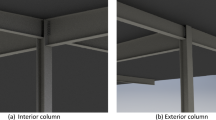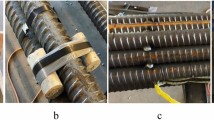Abstract
In buildings, fire represents one of the most severe environmental conditions, and therefore, should be properly accounted for in the design of high strength concrete (HSC) structural members. The increased use of HSC in buildings has raised concerns regarding the behavior of such concrete in fire. In particular, spalling at elevated temperatures, as identified in studies by a number of laboratories, is a main concern.
In this paper, results from an experimental program on the fire resistance of HSC columns are presented. The factors that influence the thermal and structural behavior of HSC concrete columns under fire conditions are discussed. Data from this study indicate that the type of aggregate, concrete strength, load intensity, and detailing and spacing of ties have an influence on the fire resistance performance of HSC columns. Further, the test results show that tie configuration (bending of ties at 135°, ties and provision of cross ties) and closer tie spacing has a significantly beneficial effect on the fire resistance of HSC columns. The results presented will generate data on the fire resistance of HSC columns, and contribute to identifying the factors that influence the behavior of HSC columns.
Similar content being viewed by others
References
National Building Code of Canada, National Research Council of Canada, Ottawa, Canada, 1995.
Canadian Standards Association, Code for the Design of Concrete Structures for Buildings, CAN3-A23.3-M94, Rexdale, Canada, 1994.
L.T. Phan, “Fire Performance of High-Strength Concrete: A Report of the State-of-the-Art,” National Institute of Standards and Technology, Gaithersburg, MD, 1996.
U. Diederichs, U.M. Jumppanen, and U. Schneider, “High Temperature Properties and Spalling Behaviour of High Strength Concrete,” in Proceedings of Fourth Weimar Workshop on High Performance Concrete, HAB Weimar, Germany, pp. 219–235, 1995.
V.K.R. Kodur, “Spalling in High Strength Concrete Exposed to Fire—Concerns, Causes, Critical Parameters and Cures,” in Proceedings (CD ROM): Advanced Technologies in Structural Engineering, ASCE Structures Congress, Philadelphia, PA, 2000.
V.K.R. Kodur and Mohamed Sultan, “Behaviour of High-strength Concrete Columns Exposed to Fire,” in Proceedings, Concrete Canada International Conference Symposium, vol. 4, Sherbrooke, Canada, pp. 217–232, 1998.
V.K.R. Kodur, R. McGrath, J.C. Latour, and J. MacLaurin, “Experimental Studies on the Fire Endurance of High-Strength Concrete Columns,” Internal Report IR 821, IRC, National Research Council of Canada, Ottawa, Canada, 2000.
R. McGrath and V.K.R. Kodur, “Research on the Fire Resistance of High Strength Concrete Columns,” in Proceedings, CSCE Structural Specialty Conference, London, Canada, pp. 269–274, 2000.
T.T. Lie, “New Facility to Determine Fire Resistance of Columns,” Canadian Journal of Civil Engineering, vol. 7,no. 3, 1980, pp. 551–558.
T.T. Lie and J.L. Woollerton, “Fire Resistance of Reinforced Concrete Columns: Test Results,” IR 569, IRC, National Research Council of Canada, Ottawa, Canada, 1988, 302 pp.
CPCA, “Strength Design of Reinforced Concrete Column Sections,” PCACOL, Canadian Portland Cement Association, Ottawa, Canada, 1994.
American Society for Testing and Materials, “Standard Methods of Fire Endurance Tests of Building Construction and Materials,” ASTM E119–88, Philadelphia, PA, 1990.
Underwriters' Laboratories of Canada, “Standard Methods of Fire Endurance Tests of Building Construction and Materials,” CAN/ULC-S101-M89, Scarborough, Canada, 1989, 49 pp.
T.T. Lie, Ed., “Structural Fire Protection: Manual of Practice,” ASCE Manual and Reports on Engineering Practice, No. 78, American Society of Civil Engineers, New York, NY, 1993.
T.T. Lie and B. Celikkol, “Method to Calculate the Fire Resistance of Circular Reinforced Concrete Columns,” ACI Materials Journal, vol. 88,no. 1, 1991, pp. 84–91.
P.J.E. Sullivan, M.J. Terro, and W.A. Morris, “Critical Review of Fire-Dedicated Thermal and Structural Computer Programs,” Journal of Applied Fire Science, vol. 3,no. 2, 1993, pp. 113–135, 1997.
V.K.R. Kodur and T.T. Lie, “A Computer Program to Calculate the Fire Resistance of Rectangular Reinforced Concrete Columns,” in Third Canadian Conference on Computing in Civil and Building Engineering, Ottawa, Canada, 1996, pp. 11–20.
V.K.R. Kodur and Sultan Mohamed, “Thermal Properties of High Strength Concrete at Elevated Temperatures,” in CANMET-ACI-JCI International Conference on Recent Advances in Concrete Technology, Tokushima, Japan, 1998, pp. 467–480.
Swedish Building Center, High Performance Concrete Structures—Design Handbook, A Swedish Program for Research and Development, Stockholm, Sweden, 2000.
Author information
Authors and Affiliations
Rights and permissions
About this article
Cite this article
Kodur, V., Mcgrath, R. Fire Endurance of High Strength Concrete Columns. Fire Technology 39, 73–87 (2003). https://doi.org/10.1023/A:1021731327822
Issue Date:
DOI: https://doi.org/10.1023/A:1021731327822




